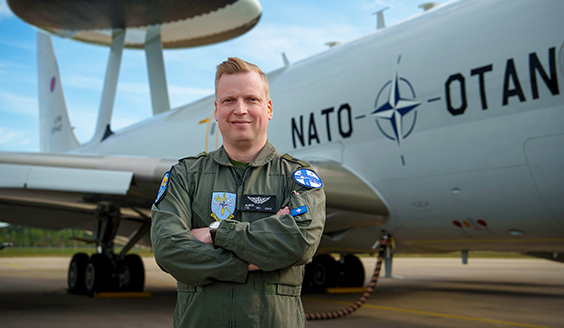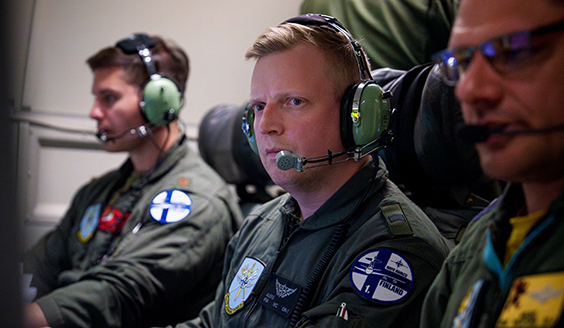Alliance’s Eyes in the Sky

Master Sergeant Aleksi Härkönen is the first Finnish crew member on a NATO’s E-3A Sentry AWACS aircraft.
Master Sergeant Aleksi Härkönen works at NATO Air Base Geilenkirchen, Germany - the home base for the Alliance’s fourteen E-3A Sentry AWACS (Airborne Warning & Control System) aircraft. The aircraft provides command and control for air operations, and it covers a surveillance area nearly the size of Finland, which is more than 312,000 square kilometres. MSgt Härkönen is the first Finnish airman operating on an AWACS aircraft.
- This was a great opportunity although I had to make the decision rapidly. I have been interested in international air force related jobs, and last year this position was offered to me. Based on my own job, I knew roughly what the position was about, he says.
Earlier Härkönen worked as a fighter controller in an Air Force command centre directing flight units which, in addition to fighters, could also include other types of aircraft. During the three-year NATO assignment, he serves as a Weapons Controller on an E-3A Sentry, being actually charged with fighter controller’s tasks.
Through conversion training to an aircraft
Before accessing an AWACS aircraft and operating on it, all crew members undergo their position related conversion training of several months. The training focuses on reviewing NATO procedures and learning the Alliance’s onboard systems. Simulator tasks and training for emergencies are also included.
- I’ve had to recall many things from the basic training I received in the Air Force. Several processes and items here are similar but there are many differences as well, for example, in the command and control system. Our operations have been integrated with each other. We´ve arranged multinational exercises in Finland and we’ve directed international flight detachments - but this is not completely the same as what we do at home.
A few weeks ago, the training that started in January ended with a long-awaited moment when Härkönen could begin planning a flight and finally took part in the mission. The first operational flight was conducted on 15 April to the Baltic region during the Ramstein Alloy exercise.
- It was great to see even on the first flight that the training and experience gained in the Air Force have excellently paved the way to work as an operator also in this environment. I can’t wait for the next flight, he says.
Apart from NATO Air Base Geilenkirchen, the NATO E-3A Component has forward-operating bases in Italy, Greece, Norway and Türkiye to support AWACS operations. Aboard an AWACS Härkönen performs operator duties that are conducted near or far depending on the E-3A Sentry’s mission. Operations may last for weeks.
- In a way, it also makes this job interesting.
Command centre on a small scale
The E-3A Sentry has a crew of minimum 15 members trained in their respective roles. There are two pilots in the controls of an AWACS, and also a flight engineer on the flight deck. The flight engineer is responsible for monitoring the engine power and flight performance of the aircraft.
The mission crew sitting at the work stations built in the cabin consists of teams specialised in surveillance, command and control and monitoring and performing of mission equipment maintenance.
A Tactical Director, as a shift supervisor, controls the activities of the mission crew tasking each team for the mission. The weapons team is headed by the Fighter Allocator who is responsible for safe conduct of all aircraft allocated to the AWACS to control. Weapons Controllers, under the direction of the Fighter Allocator, can conduct a wide range of air operations.
The flight is preceded by mission planning in which all crew members take part. It includes, for example, the review of national rules of the air and associated restrictions, military aviation regulations and other mission-specific rules and regulations and documents.
Although the fighter controller duties in the Finnish Air Force command centres have a lot in common with the duties of a Weapons Controller, serving on an AWACS brings its own special features to the job.
Onboard fighter controllers are part of an aircrew so airworthiness requirements to perform the duties must be met and ability to respond to various aviation emergencies is necessary.
- Also, the aircraft is not completely soundproof - in other words, we communicate with each other through onboard radio systems. Thus, a passive listening skill is highlighted in the job because you have to be able to pick out an essential piece of information in the midst of many messages.

Photo: OR-5 Andrew Hummel.
Important and motivating
Härkönen occupied his position at the beginning of December. Adapting to a new job and place of residence has been smooth. In addition to interesting tasks, the other positive facets of the job are the international environment and excellent location in Central Europe. You also have a chance to see the world.
Härkönen’s career path to an Air Force fighter controller started in the selection event for the Pilot Reserve Officer Course. He applied for the course but did not get selected. However, in the selection event applicants were also given information on air surveillance and control system duties, and Härkönen decided to fill in the application.
- In the back of my mind there was every little boy’s dream to get a chance to work with big and fast planes – even if you aren’t able to fly a plane yourself.
He was admitted to and completed the Reserve Officer Course. After serving his apprenticeship in the control and reporting centre, he acted as an assistant instructor for the C2 Programme conscripts of the next contingent.
- The chief of the air surveillance flight asked me if I was interested to work there, and I thought why not. I meant to stay there for only one year and then leave for studies. But I then got an opportunity to move to the operations control flight, and I decided to enter the basic level fighter controller training.
Successes experienced during AWACS training continue to motivate Härkönen even though he has already been serving for over ten years. He finds the fighter controller’s job interesting and important.
- When your tasks involve surveillance and safeguarding of territorial integrity, it makes you feel that you really do work that is meaningful. If you can support the decision-making of a fighter detachment with your own actions, it may be pivotal. A fighter controller is, through his own actions, able to contribute to achieving the joint desired outcome. You can make the right decisions in high-speed situations, for example, to save lives in a real situation.
E-3A Sentry AWACS (Airborne Warning & Control System)
- The E-3A Sentry is evolved from a modified Boeing 707 passenger aircraft.
- The E-3A Sentry has a crew of minimum 15.
- Aircraft are equipped with Doppler radar.
- Endurance is more than 10 hours. All E-3As are air-refuelable.
- Radar coverage is over 312,000 km², nearly the entire area of Finland.
- Read more on NATO website



